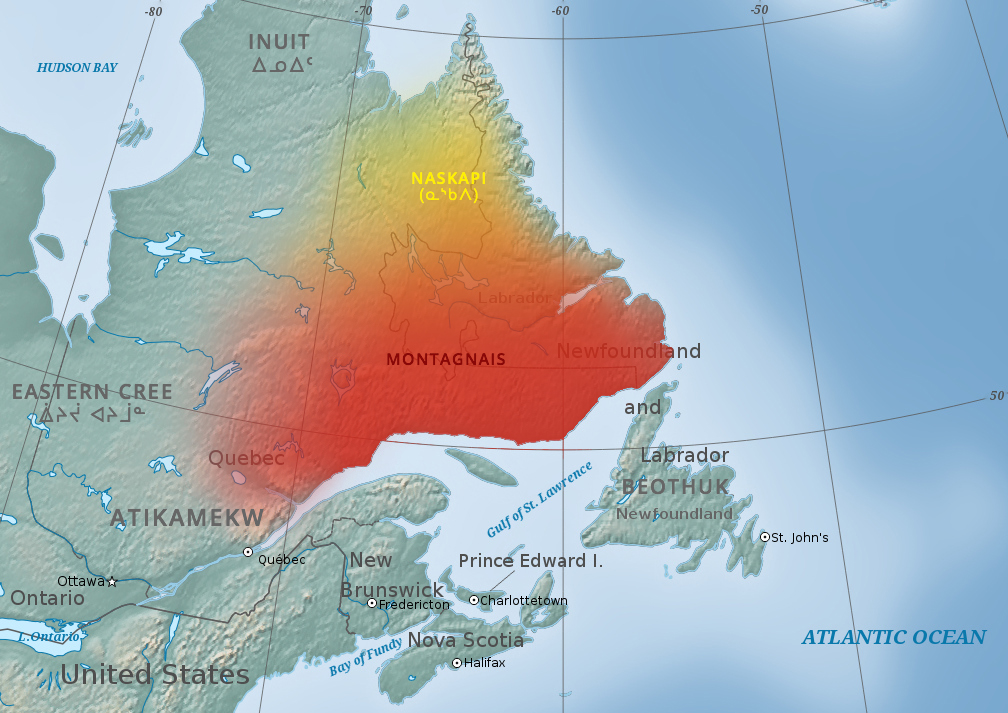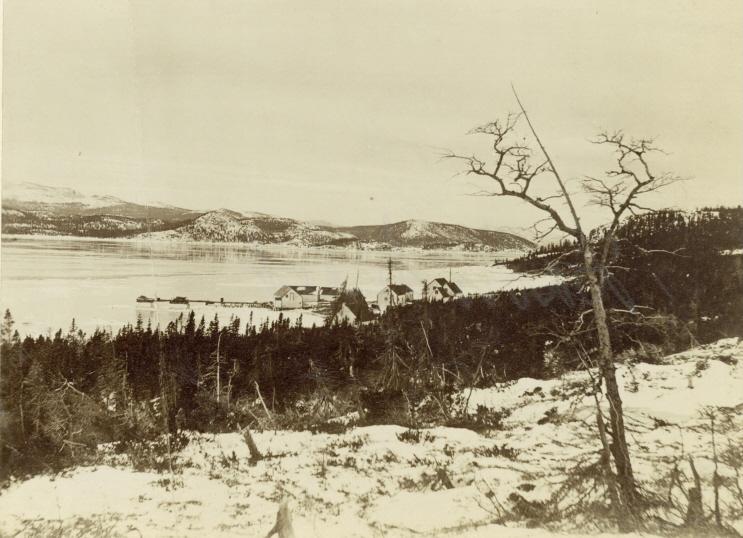|
Naskapi
The Naskapi (Nascapi, Naskapee, Nascapee) are an Indigenous people of the Subarctic native to the historical region St'aschinuw (ßĺőßĹŽ ßÉŐßöůßĺőßôäßÉĄ, meaning 'our Clusivity, [inclusive] land'), which was located in present day northern Quebec and Labrador, neighbouring Nunavik. They are closely related to Innu First Nations in Canada, People, who call their homeland ''Nitassinan''. Innu people are frequently divided into two groups, the Neenoilno (called ''Montagnais'' by French people) who live along the north shore of the Gulf of Saint Lawrence, in Quebec, and the less numerous Naskapi who live farther north. The Innu themselves recognize several distinctions (e.g. Mushuau Innuat, Maskuanu Innut, Uashau Innuat) based on different regional affiliations and various dialects of the Innu language. The word "Naskapi" (meaning "people beyond the horizon") first made an appearance in the 17th century and was subsequently applied to Innu groups beyond the reach of missionary in ... [...More Info...] [...Related Items...] OR: [Wikipedia] [Google] [Baidu] |
Kawawachikamach, Quebec
Kawawachikamach () is a Naskapi/Iyiyiw First Nations reserve and community at the south end of Lake Matemace (where it joins Lake Peter), approximately northeast of Schefferville, Quebec, Canada. It belongs to the Naskapi Nation of Kawawachikamach. The village was built by the Naskapi/Iyiyiw from 1980 to 1983. The language spoken is Iyiyiw-Imuun, a dialect closely related to Innu and Iynu ( East Cree). The name means "the winding river". Access to the village is by way of Schefferville Airport or railway from Sept-├Äles to Schefferville, then by way of a road from the centre of Schefferville. With the demise of Schefferville as a residential centre for the iron ore mining operations, Kawawachikamach and Matim├ękush are now the main communities in the region. Telephone and postal services are provided from the Schefferville exchange by Telebec and from the Schefferville Post Office, while electricity is provided by the Schefferville Power Company. The Naskapi/Iyiyiw prov ... [...More Info...] [...Related Items...] OR: [Wikipedia] [Google] [Baidu] |
Neenoilno
The Innu/Ilnu ('man, person'), formerly called Montagnais (French for ' mountain people'; ), are the Indigenous Canadians who inhabit northeastern Labrador in present-day Newfoundland and Labrador and some portions of Quebec. They refer to their traditional homeland as ''Nitassinan'' ('Our Land', ßôéßĹĽßöůßô»ßôçßôÉ) or ''Innu-assi'' ('Innu Land'). The ancestors of the modern First Nations were known to have lived on these lands as hunter-gatherers for many thousands of years. To support their seasonal hunting migrations, they created portable tents made of animal skins. Their subsistence activities were historically centred on hunting and trapping caribou, moose, deer, and small game. Their language, which changed over time from Old Montagnais to Innu-aimun (popularly known since the French colonial era as Montagnais), is spoken throughout Nitassinan, with certain dialect differences. It is part of the CreeÔÇôMontagnaisÔÇôNaskapi dialect continuum, and is unrelated to th ... [...More Info...] [...Related Items...] OR: [Wikipedia] [Google] [Baidu] |
Innu People
The Innu/Ilnu ('man, person'), formerly called Montagnais (French for ' mountain people'; ), are the Indigenous Canadians who inhabit northeastern Labrador in present-day Newfoundland and Labrador and some portions of Quebec. They refer to their traditional homeland as '' Nitassinan'' ('Our Land', ßôéßĹĽßöůßô»ßôçßôÉ) or ''Innu-assi'' ('Innu Land'). The ancestors of the modern First Nations were known to have lived on these lands as hunter-gatherers for many thousands of years. To support their seasonal hunting migrations, they created portable tents made of animal skins. Their subsistence activities were historically centred on hunting and trapping caribou, moose, deer, and small game. Their language, which changed over time from Old Montagnais to Innu-aimun (popularly known since the French colonial era as Montagnais), is spoken throughout Nitassinan, with certain dialect differences. It is part of the CreeÔÇôMontagnaisÔÇô Naskapi dialect continuum, and is unrelate ... [...More Info...] [...Related Items...] OR: [Wikipedia] [Google] [Baidu] |
Naskapi Language
Naskapi (also known as / in the Naskapi language) is an Algonquian language spoken by the Naskapi in Quebec and Labrador, Canada. It is written in Eastern Cree syllabics. The term Naskapi is chiefly used to refer to the language of the people living in the interior of Quebec and Labrador in or around Kawawachikamach, Quebec. Naskapi is a " y-dialect" that has many linguistic features in common with the Northern dialect of East Cree, and also shares many lexical items with the Innu language. Although there is a much closer linguistic and cultural relationship between Naskapi and Innu than between Naskapi and other Cree language communities, Naskapi remains unique and distinct from all other language varieties in the Quebec-Labrador peninsula. Phonology Each stop has voiced allophones as and pre-aspirated allophones as .MacKenzie, Marguerite. 1994. * Long vowels: , , * Short vowels: , , Orthography There are two writing systems used for Naskapi language. One is La ... [...More Info...] [...Related Items...] OR: [Wikipedia] [Google] [Baidu] |
Cree
The Cree, or nehinaw (, ), are a Indigenous peoples of the Americas, North American Indigenous people, numbering more than 350,000 in Canada, where they form one of the country's largest First Nations in Canada, First Nations. They live primarily to the north and west of Lake Superior in the Provinces and territories of Canada, provinces of Alberta, Labrador, Manitoba, the Northwest Territories, Ontario, and Saskatchewan. Another roughly 27,000 live in Quebec. In the United States, the Cree, historically, lived from Lake Superior westward. Today, they live mostly in Montana, where they share Rocky Boy's Indian Reservation with Ojibwe (Chippewa) people. A documented westward migration, over time, has been strongly associated with their roles as traders and hunters in the North American fur trade. Sub-groups and geography The Cree are generally divided into eight groups based on dialect and region. These divisions do not necessarily represent ethnic subdivisions within th ... [...More Info...] [...Related Items...] OR: [Wikipedia] [Google] [Baidu] |
Davis Inlet
Davis Inlet was a Naskapi community in the Provinces and territories of Canada, Canadian province of Newfoundland and Labrador, formerly inhabited by the Mushuau Innu First Nation. It was named for its adjacent fjord, itself named for English explorer, John Davis (explorer), John Davis, who in 1587 charted the region as part of ongoing efforts to find the Northwest Passage to the Pacific Ocean, Pacific. The residents of Davis Inlet were relocated to the new community of Natuashish, away, in 2002. Settlement The community developed around 1924 during a period of sparse Reindeer, caribou populations when the Innu began spending their summers along the shoreline of Davis Inlet. This location was chosen because of its accessibility, its offering of other non-caribou food sources, and the presence of a trading post, operated by the Hudson's Bay Company, that was able to supply Animal trapping, traps, ammunition, tobacco, butter, sugar and flour to the Innu in exchange for furs. Dav ... [...More Info...] [...Related Items...] OR: [Wikipedia] [Google] [Baidu] |
Quebec
Quebec is Canada's List of Canadian provinces and territories by area, largest province by area. Located in Central Canada, the province shares borders with the provinces of Ontario to the west, Newfoundland and Labrador to the northeast, New Brunswick to the southeast and a coastal border with the territory of Nunavut. In the south, it shares a border with the United States. Between 1534 and 1763, what is now Quebec was the List of French possessions and colonies, French colony of ''Canada (New France), Canada'' and was the most developed colony in New France. Following the Seven Years' War, ''Canada'' became a Territorial evolution of the British Empire#List of territories that were once a part of the British Empire, British colony, first as the Province of Quebec (1763ÔÇô1791), Province of Quebec (1763ÔÇô1791), then Lower Canada (1791ÔÇô1841), and lastly part of the Province of Canada (1841ÔÇô1867) as a result of the Lower Canada Rebellion. It was Canadian Confederation, ... [...More Info...] [...Related Items...] OR: [Wikipedia] [Google] [Baidu] |
First Nations In Canada
''First Nations'' () is a term used to identify Indigenous peoples in Canada who are neither Inuit nor M├ętis. Traditionally, First Nations in Canada were peoples who lived south of the tree line, and mainly south of the Arctic Circle. There are 634 recognized List of First Nations band governments, First Nations governments or bands across Canada. Roughly half are located in the provinces of Ontario and British Columbia. Under Canadian Charter of Rights and Freedoms, Charter jurisprudence, First Nations are a "designated group", along with women, Visible minority, visible minorities, and people with physical or mental disabilities. First Nations are not defined as a visible minority by the criteria of Statistics Canada. North American indigenous peoples have cultures spanning thousands of years. Many of their oral traditions accurately describe historical events, such as the 1700 Cascadia earthquake, Cascadia earthquake of 1700 and the 18th-century Tseax Cone eruption. Writ ... [...More Info...] [...Related Items...] OR: [Wikipedia] [Google] [Baidu] |
Nunavik
Nunavik (; ; ) is an area in Canada which comprises the northern third of the province of Quebec, part of the Nord-du-Qu├ębec region and nearly coterminous with Kativik. Covering a land area of north of the 55th parallel, it is the homeland of the Inuit of Quebec and part of the wider Inuit Nunangat. Almost all of the 14,045 inhabitants ( 2021 census) of the region, of whom 90% are Inuit, live in fourteen northern villages on the coast of Nunavik and in the Cree reserved land (TC) of Whapmagoostui, near the northern village of Kuujjuarapik. means "great land" in the local dialect of Inuktitut and the Inuit inhabitants of the region call themselves . Until 1912, the region was part of the District of Ungava of the Northwest Territories. Negotiations for regional autonomy and resolution of outstanding land claims took place in the 2000s. The seat of government would be Kuujjuaq. Negotiations on better empowering Inuit political rights in their land are still ongoing. H ... [...More Info...] [...Related Items...] OR: [Wikipedia] [Google] [Baidu] |
Indigenous People Of The Subarctic
Indigenous peoples of the Subarctic are the Aboriginal peoples who live in the Subarctic regions of the Americas, Asia, and Europe, located south of the true Arctic at about 50┬░N to 70┬░N latitude. This region includes the interior of Alaska, the Western Subarctic or western Canadian Shield and Mackenzie River drainage area, the Eastern Subarctic or Eastern Canadian Shield, and most of Fennoscandia, Northwestern Russia and Siberia.History of Indigenous Art in Canada ''.'' (retrieved 29 Dec 2010) Peoples of subarctic |
Nitassinan
Nitassinan () is the ancestral homeland of the Innu, an indigenous people of Eastern Quebec and Labrador, Canada. Nitassinan means "our land" in the Innu language. The territory covers the eastern portion of the Labrador peninsula.'' Nitassinan: The Innu Struggle to Reclaim Their Homeland'', Douglas & McIntyre Douglas and McIntyre (2013) Ltd. is a Canadian book publishing firm. Douglas & McIntyre was founded by James Douglas and Scott McIntyre in 1971 as an independent publishing company based in Vancouver. Reorganized with new owners in 2008 as D&M ..., December 1991, 240pp, by Marie Wadden, (book link), (retrieved 11/19/2012) The area was known as '' Markland'' in Greenlandic Norse, and its inhabitants were known as the '' Skr├Žling''. References Innu Geography of Newfoundland and Labrador Geography of Quebec Cultural regions of Canada {{NorthAm-native-stub gv:Nitassinan ... [...More Info...] [...Related Items...] OR: [Wikipedia] [Google] [Baidu] |



